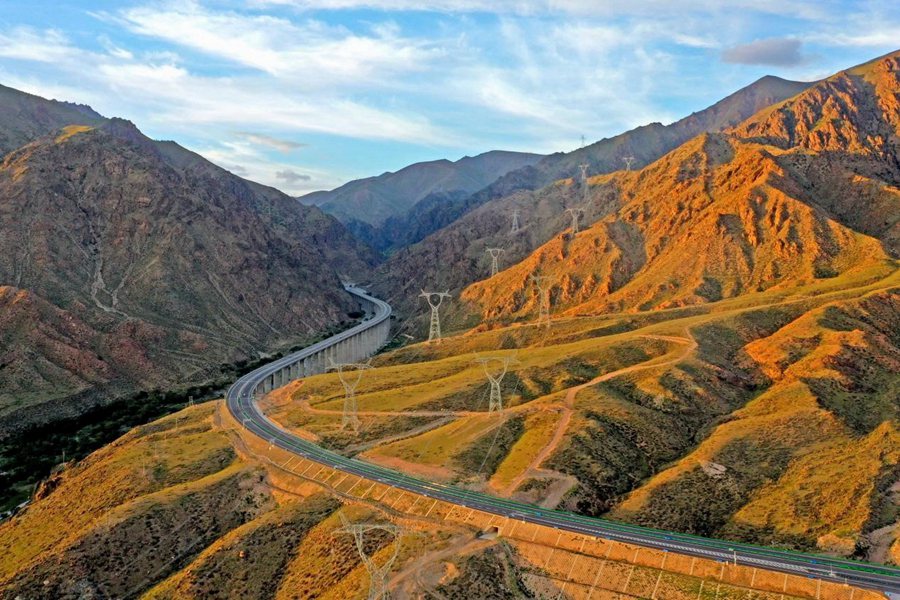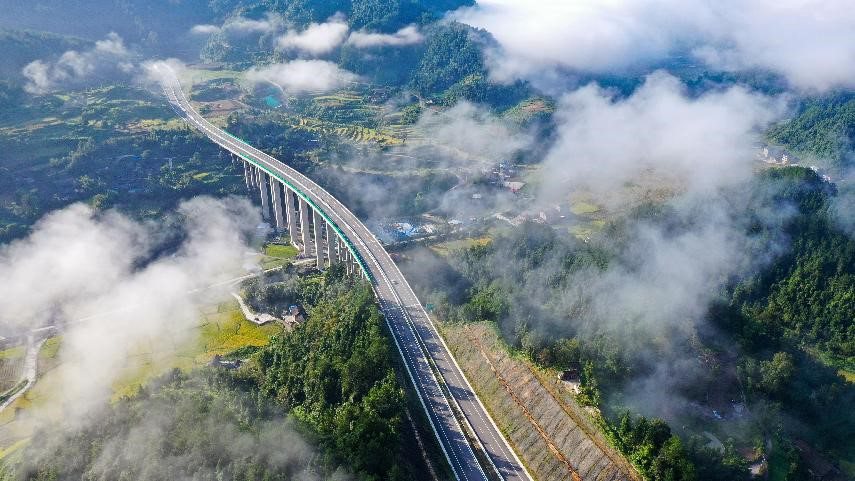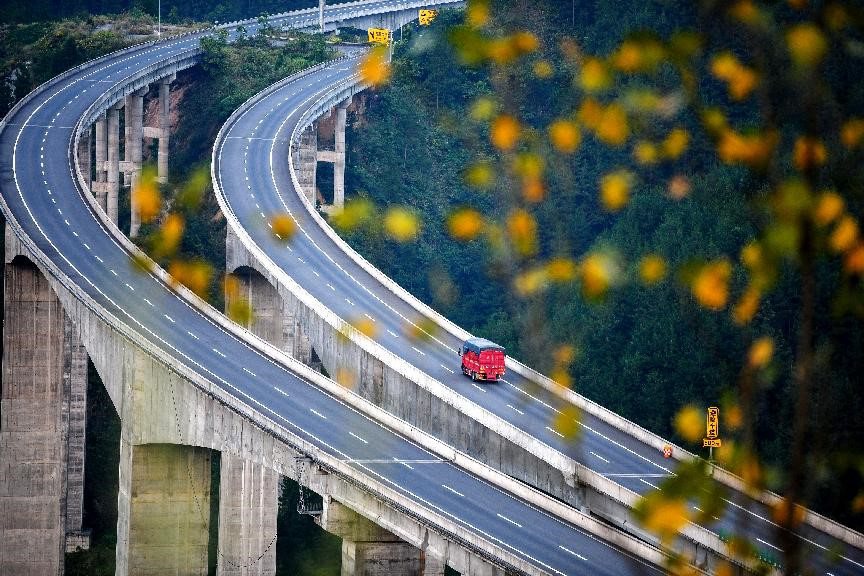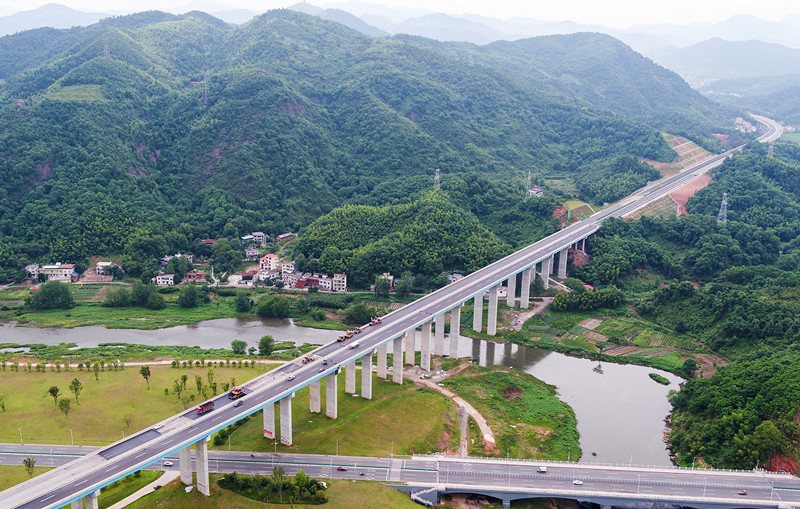China achieves remarkable results in building extensive road network
Pingxiang-Lianhua expressway, hailed as the most beautiful expressway in east China’s Jiangxi province, is expected to open to traffic on Sept. 28. With a length of about 75 km, it will play an important role in speeding up the social and economic development of western Jiangxi.

Photo taken on August 27, 2021 shows the exit of the East Tianshan Mountain Tunnel on G575 national expressway, northwest China’s Xinjiang Uygur autonomous region. (People’s Daily Online/Cai Zengle)
On August 23, the construction of the section of the Tianshan Shengli tunnel in the largest and most dangerous fault zone of the project was completed, bringing the tunnel onto a fast track of construction.
As a crucial part of the Urumqi-Yuli expressway in northwest China’s Xinjiang Uygur autonomous region, the tunnel will be the longest expressway tunnel in the world upon completion.
On August 21, a 295-km-long expressway linking the cities of Nagqu and Lhasa in southwest China’s Tibet autonomous region, also a section of the G6 Beijing-Tibet Expressway connecting Beijing with Tibet, began operation.
While increasing the total length of Tibet’s high-grade highways to 1,105 km, the completion of the section has brought hope of achieving prosperity to people of all ethnic groups in the snow-capped plateau.

Vehicles run on an expressway linking Shiqian county, Tongren city, southwest China’s Guizhou province with Yuping Dong autonomous county of Tongren, Sept. 9, 2021. (People’s Daily Online/Hu Panxue)
Huge as it already is, China’s road network still expands constantly, providing continuous and strong support for the country’s economic development and improvement in people’s livelihood.
Believing that building the roads is the first step to becoming prosperous, China has attached great importance to building its strength in transportation. Since 2012, the country has further improved the scale, technological level, and coverage of its road network.
As of the end of 2020, the total length of China’s roads reached around 5.2 million km, and the country’s road density rose to 54.15 km/100 sq. km.
The first expressway on the Chinese mainland, which linked the downtown area of east China’s Shanghai with the city’s satellite county of Jiading, now Jiading district, was put into operation in 1988.

Photo taken on August 6, 2021 shows an expressway bridge in Tonggu township, Youyang Tujia and Miao autonomous county, southwest China’s Chongqing municipality. (People’s Daily Online/He Yi)
At the end of 2013, China had 104,400-km expressways in total, ranking first in the world in terms of the total length of expressways. By the end of 2020, the country’s expressways registered a total length of 161,000 km, remaining the first in the world. Meanwhile, expressways accounted for 3.1 percent of the total length of roads in China and covered more than 98 percent of the country’s cities with a population of more than 200,000.
In addition, the total length of rural roads reached 4.38 million km as of the end of last year, and all the townships and administrative villages in poverty-stricken areas with the right conditions were accessible by hardened roads and provided with bus and mail routes.
Over the past more than three decades, the country’s road network has witnessed significant improvement in comprehensive service functions, traffic capacity, traffic speed, and comfort.
Since the launch of the reform and opening-up policies, China has built a number of bridges that involve difficult engineering tasks and high technologies. As of the end of 2020, the number and total length of highway bridges across China reached 912,800 and nearly 66.29 million linear meters respectively, and six of the top ten suspension bridges and seven of the top ten cable-stayed bridges in the world in terms of span were in China.

Construction workers pave asphalt on the surface of a super large bridge over the Pingshui River in Pingxiang, east China’s Jiangxi province, August 11, 2021. The bridge is part of an expressway connecting the urban areas of Pingxiang city with Lianhua county of the city. (People’s Daily Online/Li Guidong)
China increased the number and total length of its highway tunnels to 21,316 and around 22 million linear meters respectively by the end of 2020. Many of its tunnel projects, such as the Qinling Zhongnanshan highway tunnel completed in 2007 and the Xueshan No.1 tunnel that opened to traffic in 2017 in northwest China’s Qinghai province, have reached world-class level.
Stressing sci-tech innovation and advancing environmental protection, China has been committed to promoting the sustainable and sound development of roads.
Technologies such as remote sensing, aerial survey, and computer-aided design (CAD) have been widely used in survey and design for road construction. Besides, advanced technologies related to such areas as integrated treatment of soft soil foundation, modified asphalt, and pavement skid resistance, as well as modern equipment including large-scale compaction machinery, paving machinery and mixing equipment have been extensively adopted across the country.
In June 2016, China’s Ministry of Transport issued a guideline on eco-friendly road construction, which was followed by the construction and completion of a good number of pilot projects. By the end of last year, the country’s recycling rate of waste road-surface materials in expressway projects reached 95 percent.
From breaking certain shackles that hold the development of roads to basically suiting the needs of economic and social development, an extensive road network has taken shape in China, said Sun Wenjian, spokesperson with the Ministry of Transport.
The development of road network has effectively driven the land development and industrial restructuring of areas along the routes, played a significant role in supporting regional economic and social development, and improved the transportation conditions of the country’s vast rural areas, especially poverty-stricken areas, laying a solid foundation for building a moderately prosperous society in all respects, Sun noted.
Photos
Related Stories
- Du'an in Guangxi invests a lot in upgrading roads in rural areas
- China's rural road mileage reaches 4.38 mln km
- Chinese-built ring roads reduce traffic jams in Kenya
- All Xinjiang villages have access to asphalt and concrete roads, broadband services: white paper
- New road brings hope in Tibet
- China unveils list of top 10 most beautiful rural roads
Copyright © 2021 People's Daily Online. All Rights Reserved.










